Gone are the days of rigid, 5 or 10-year planning cycles that don't leave room for flexibility and innovation. To stay ahead of the curve, you need a dynamic and execution-ready strategic plan that can guide your business through the ever-evolving landscape.
In this article, we'll show you how to write a strategic plan in 6 simple steps. By the end, you'll have a comprehensive, actionable strategic plan that will help you align your organization on the path to success.
💡Pro tip: Use our customizable, free Strategic Planning Template that includes all the key elements of a strategic plan to streamline your strategic planning process.
Follow this guide step-by-step, or skip to the part you're most interested in:
- Pre-Planning Phase: Build The Foundation
- Key Elements of a Strategic Plan
- How To Write A Strategic Plan In 6 Simple Steps
- Develop An Iterative Strategic Planning Process
- 3 Strategic Plan Examples To Get You Started
- How To Achieve Organizational Alignment With Your Strategic Plan
- Quick Overview of Key Steps In Writing A Strategic Plan
- Create An Execution-Ready Strategic Plan With Cascade 🚀
Before jumping into the planning phase, it's essential to lay the groundwork.
Pre-Planning Phase: Build The Foundation
Your strategic planning process should start well before you write your strategic plan. The pre-planning phase is crucial for gathering the data and strategic insights necessary to create an effective plan.
1. Conduct Strategic Analysis
Strategic analysis is a crucial step before writing your strategic plan. It's like building a house – you wouldn't start constructing the walls without a strong foundation, and the same goes for strategic planning. It equips you with the knowledge and insights to create a strategic plan that is well-targeted, addresses your actual situation, and positions your organization for success.
Use a strategic framework like GAP analysis, SWOT analysis, Porter's Five Forces, Ansoff matrix, McKinsey 7S model, or GE matrix to structure your analysis sessions. Incorporating a risk matrix can also help align and decide on key strategic priorities.
Additionally, consider running a strategic planning workshop with your team. Co-creating the plan with stakeholders is a significant advantage, as it fosters a sense of ownership and increases the likelihood of successful strategy execution. According to McKinsey, initiatives where employees contribute to development are 3.4 times more likely to succeed.
2. Choose your strategic planning model
Before creating your strategic plan, decide on the structure you will use. There are hundreds of ways to structure a strategic plan. You've likely heard of famous strategic models such as OKRs and the Balanced Scorecard.
But beyond the well-known ones, there's also a myriad of other planning models. However, many models that work well on paper often fail to meet organizational needs in practice.
Common issues with many models include:
- Complexity: People get lost in terminology rather than focusing on execution
- Scalability: They work well for small organizations but fail when extended across multiple teams
- Rigidity: They force unnecessary layers, hindering flexibility
- Lack of measurability: They state outcomes well but fail to help measure success
- Adaptability: They don’t adjust well to changing economic landscapes
Our goal is to provide a simpler, more effective way to write a strategic plan. The Cascade Strategy Model, refined over years of working with +20,000 teams, offers a proven approach to strategic planning that is adaptable, scalable, and effective for organizations of all sizes.
In the following sections, we'll explore the key elements and steps to write a strategic plan based on the Cascade Model.
Key Elements Of A Strategic Plan
.avif)
The key elements of a strategic plan using the Cascade Model work together to create a clear and actionable roadmap for your organization.
Think of it as a step-by-step guide, where each element builds upon the previous one:
- Vision: Where do you want to get to?
- Values: How will you behave on the journey?
- Focus Areas: What are going to be your strategic priorities?
- Strategic objectives: What do you want to achieve?
- Actions and projects: How are you going to achieve the objectives?
- KPIs: How will you measure success?
These interconnected elements ensure everyone in your organization is aligned on your overall strategy. Above all, the Cascade Model is intended to be execution-ready—in other words, it has been proven to deliver success far beyond strategic planning.
How To Write A Strategic Plan In 6 Simple Steps
To create a powerful strategic plan, follow this clear, step-by-step process using the Cascade Model.
💡 Pro Tip: If you want to follow along as we cover each step, you can use our Strategic Planning Template spreadsheet (Excel format), or, for the best experience, sign up for instant access to our free Strategic Planning Template in Cascade.
1. Vision
Your vision statement is your organization's anchor - it defines where you want to get to.
A good vision statement can help funnel your strategy towards long-term goals that matter the most to your organization, and everything you write in your plan from this point on will help you get closer to achieving your vision.
Trying to do too much at once is a surefire way to sink your strategic plan. By creating a clear and inspiring vision statement, you can avoid this trap and provide guidance and inspiration for your team.
For example, a bike manufacturing company might have a vision statement like, “To be the premier bike manufacturer in the Pacific Northwest.” This statement clearly articulates the organization's goals and is a powerful motivator for the team.
In short, don't start your strategic plan without a clear vision statement. It will keep your organization focused and help you navigate toward success.
📚Recommended read: How to Write a Vision Statement (With Examples, Tips, and Formulas)
Alongside your organization’s vision, a well-crafted mission statement is essential. It succinctly defines your purpose, culture, goals, and values, serving as a foundation for your strategic plan. Ensure your mission statement is clear and aligns with your organization’s vision to drive cohesive and effective strategies.
2. Values
Values are the enablers of your vision statement—they represent how your organization will behave as you work towards your strategic goals.
Make sure to integrate your organization's core values into everyday operations and interactions. In today's highly-competitive world, it's crucial to remain steadfast in your values and cultivate an organizational culture that's transparent and trustworthy.
Companies with the best company cultures consistently outperform competitors and their average market by up to 115.6%, as reported by Glassdoor.
For example, a bike manufacturing company might have core values like:
- Innovation
- Excellence
- Passion
- Accountability
These values reflect the organization's desire to become the leading bike manufacturer, while still being accountable to employees, customers, and shareholders.
👉 You can create and add your values, mission and vision statements directly in Cascade. This ensures your company's core principles remain top of mind for everyone.

📚When you're ready to start creating some company values, check out our guide, How To Create Company Values.
3. Focus Areas
Your focus areas are the strategic priorities that will keep your team on track and working toward the company's mission statement and vision. They represent the high-level areas that you need to focus on to achieve desired business outcomes.
In fact, companies with clearly defined priorities are more likely to achieve their objectives. According to a case study by the Harvard Business Review, teams that focus on a small number of key strategic initiatives are more likely to succeed than those that try to do too much.
Rather than spreading your resources too thin over multiple focus areas, prioritize three to five.
Following our manufacturing example above, some good focus areas include:
- Aggressive growth
- Producing the nation's best bikes
- Becoming a modern manufacturer
- Becoming a top place to work
Your focus areas should be tighter in scope than your vision statement, but broader than specific goals, time frames, or metrics.
With a clear set of focus areas, your team will be better able to prioritize their work and stay focused on the most important things, which will ultimately lead to better business results.
👉 In Cascade, you can add focus areas while creating or importing an existing strategic plan from a spreadsheet.
With Cascade's Focus Area deep-dive functionality, you will be able to:
- Review the health of your focus areas in one place
- Get a breakdown by plans, budgets, resources, and people behind each strategic priority
- See something at-risk? Drill down into each piece of work regardless of how many plans it's a part of
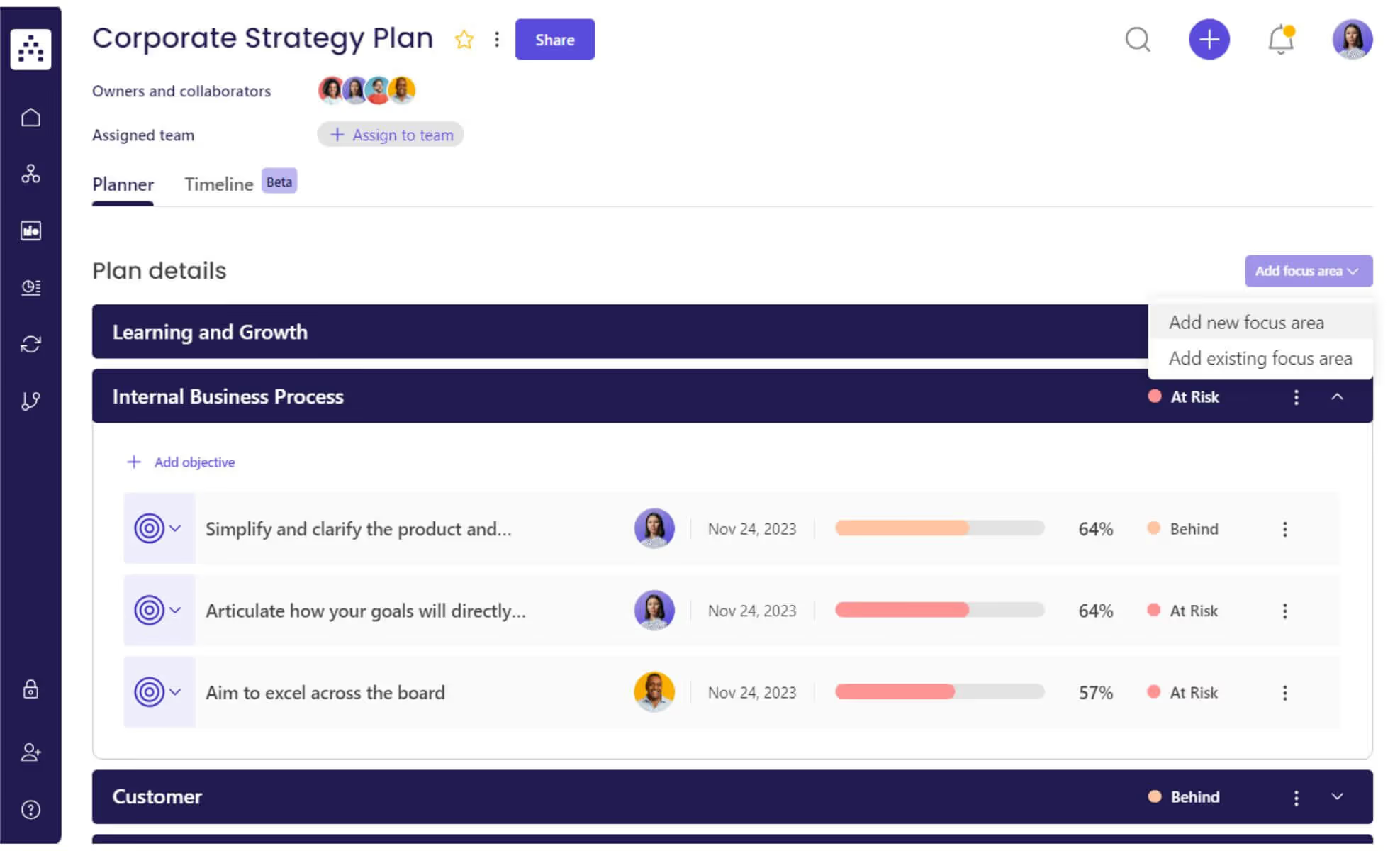
📚Recommended read: Strategic Focus Areas: How to create them + Examples
4. Strategic Objectives
Strategic objectives are the specific and measurable outcomes you want to achieve. While they should align with your focus areas, they should be more detailed and have a clear deadline.
According to the 2022 State of High Performing Teams report, there is a strong correlation between goals and success not only at the individual and team level but also at the organizational level. Here's what they found:
- Employees who are unaware of their company's strategic goals are over three times more likely to work at a company experiencing a revenue decline than employees who are aware of the goals
- Companies with shrinking revenues are almost twice as likely to have employees with unclear work expectations.
Jumping straight into actions without defining clear objectives is a common mistake that can lead to missed opportunities or misalignment between strategy and execution.
To avoid this pitfall, we recommend you add between three and six objectives to each focus area.
It's here that we need to start being a bit more specific for the first time in your strategic planning process. Let's take a look at an example of a well-written strategic objective:
- Continue top-line growth that outpaces the industry by 31st Dec 2023.
This is too specific to be a focus area. While it's still very high level, it indicates what the company wants to accomplish and includes a clear deadline. Both these aspects are critical to a good strategic objective.
Your strategic objectives are the heart and soul of your plan, and you need to ensure they are well-crafted. So, take the time to create well-planned objectives that will help you achieve your vision and lead your organization to success.
👉 Adding objectives in Cascade is intuitive, straightforward, and accessible. With one click, you'll open the objective sidebar and fill out the details. These can include a timeline, the objective's owner, collaborators, and how your objective will be measured (success criteria).

📚Recommended read: What are Strategic Objectives? How to write them + Examples
5. Actions and projects
Once you've defined your strategic objectives, the next step is to identify the specific strategic initiatives or projects that will help you achieve those objectives. They are short-term goals or actionable steps you or your team members will take to accomplish objectives. They should leverage the company's resources and core competencies.
Effective projects and actions in your strategic plan should:
- Be specific
- Contain a deadline
- Have an owner
- Align with at least one of your strategic objectives
- Provide clarity on how you or your team will achieve the strategic objective
Let's take a look at an example of a well-written project continuing with our bike manufacturing company using the strategic objective from above:
Strategic objective: Continue top-line growth that outpaces the industry by 31st Dec 2023.
Project: Expand into the fixed gear market by 31st December 2023.
This is more specific than the objective it links to, and it details what you will do to achieve the objective.
Actions and projects are where the rubber meets the road. They connect the organizational strategic goals with the actual capabilities of your people and the resources at their disposal. Defining projects is a vital reality check every strategic plan needs.
👉You can create actions and projects easily in Cascade! From the Objective sidebar, you can choose to add a project or action under your chosen objective. In the following steps, you can assign an owner and timeline to each action or project.

Plus, in Cascade, you can track the progress of each project or action in four different ways. You can do it manually, via milestones, checklists, or automatically by integrating with Jira and 1000+ other available integrations.
📚Recommended read: What are Strategic Initiatives? How to Develop & Execute + Examples
6. Key Performance Indicators (KPIs)
Measuring progress towards strategic objectives is essential to effective strategic control and business success. That's where Key Performance Indicators (KPIs) come in.
KPIs are measurable values that track progress toward achieving key business objectives. They help you stay on track and focused on your organization's strategic goals.
To get the most out of your KPIs, make sure you link them to a specific goal or objective. This way, you'll avoid creating KPIs that don't contribute to your objectives and distract you from focusing on what matters.
Ideally, you will add both leading and lagging KPIs to each objective so you can get a more balanced view of how well you're progressing. Leading KPIs can indicate future performance, while lagging KPIs show how well you've done in the past.
Think of KPIs as a form of signpost in your organization. They provide critical insights that inform business leaders of their organization's progress toward key business objectives. Plus, they can help you identify opportunities faster and capitalize on flexibility.
👉 In Cascade, you can add measures while creating your objectives or add them afterward. Open the Objective sidebar and add your chosen measure.
When you create your Measure, you can choose how to track it. Using Cascade, you can track it manually or automatically. You can automate tracking via 1000+ integrations, including Excel spreadsheets and Google Sheets. This way, you can save time and ensure that your team has up-to-date information for faster and more confident decision-making.

📚Recommended reads:
- 10 Popular KPI Software Tools To Connect & Visualize Your Data (2025 Guide)
- How To Track KPIs To Hit Your Business Goals
Develop An Iterative Strategic Planning Process
Developing an iterative strategic planning process is essential for staying adaptable and responsive to change. This approach involves continuously reviewing and refining your strategies to ensure they remain relevant in a dynamic business environment. Regularly assess your plan's effectiveness, gather stakeholder feedback, analyze performance data, and make necessary adjustments.
This cycle of strategic planning, execution, and evaluation helps identify areas for improvement, fosters innovation, and keeps your organization aligned with its long-term goals. By adopting an iterative process, you can navigate challenges more effectively and maintain a competitive edge.
📚 Check out our article Develop An Iterative Strategic Planning Process to dive into this topic
3 Strategic Plan Examples To Get You Started
Corporate Strategic Plan
Following the steps outlined above, you should end up with a strategic plan that looks something like this:
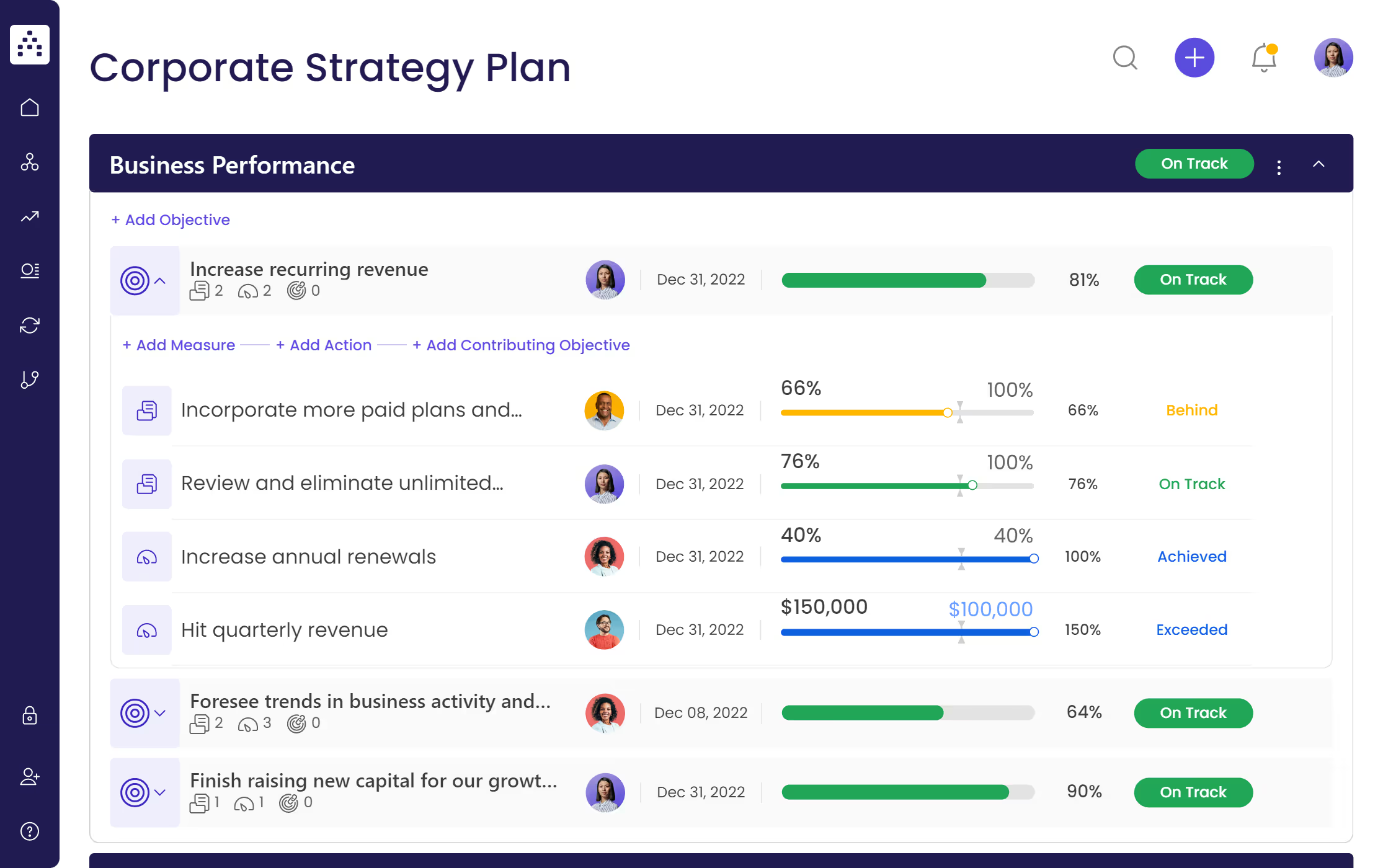
This is a preview of a corporate strategic plan template that is pre-filled with examples. Here, you can use the template for free and begin filling it out to align with your organization's needs. Plus, it's suitable for organizations of all sizes and any industry.
Once you fill in the template, you can also switch to the timeline view. You'll get a complete overview of how the different parts of your plan are distributed across the roadmap in a Gantt chart view.

This template will help you create a structured approach to the strategic planning process, focus on key strategic priorities, and drive accountability to achieve necessary business outcomes.
👉Get your free corporate strategic plan template here.
Coca-Cola Strategic Plan
Need a bit of extra inspiration with your plan? Check out this strategic plan example, inspired by Coca-Cola's business plan:
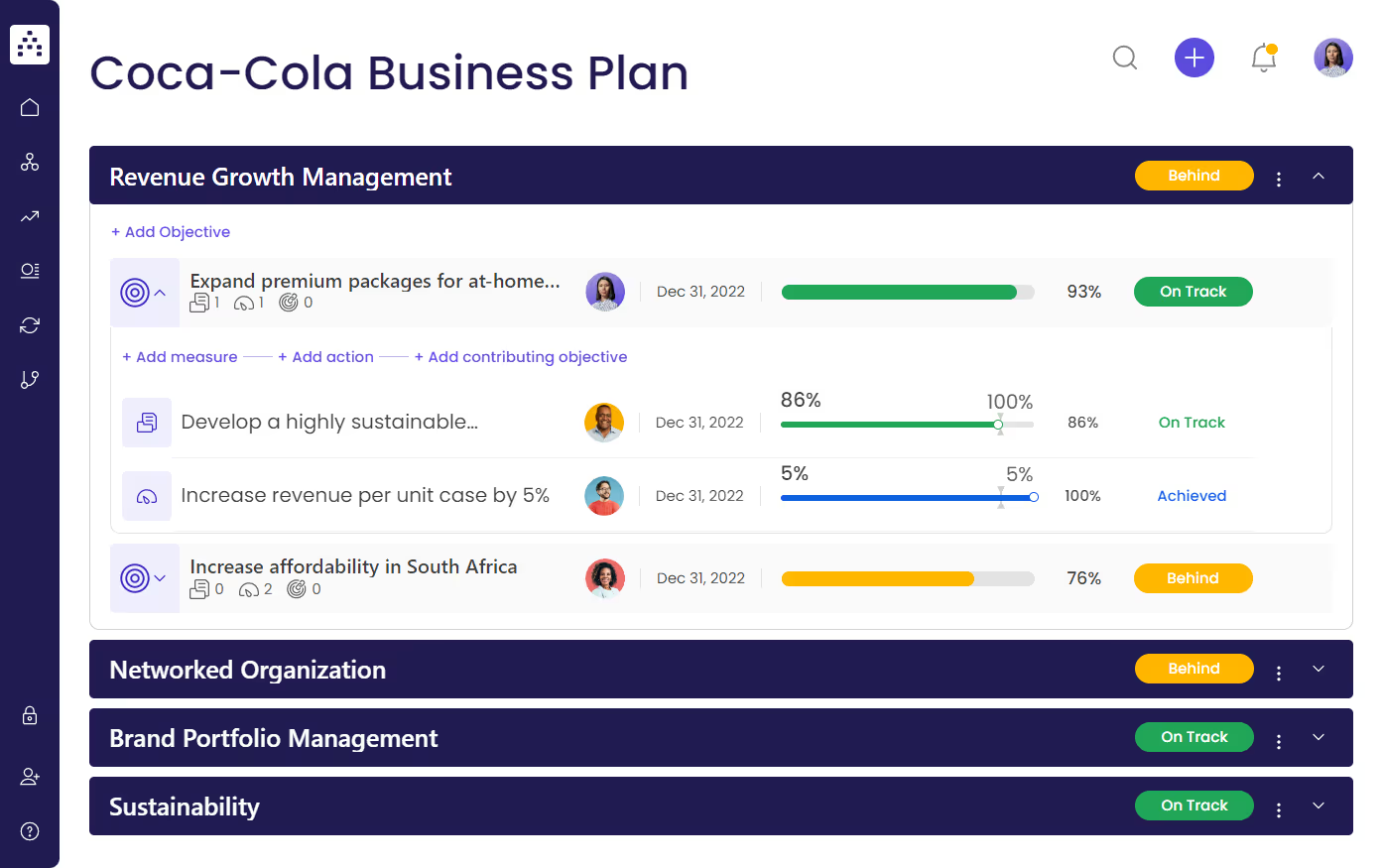
This strategic planning template is pre-filled with Coca-Cola's examples so you can inspire your strategic success on one of the most iconic brands on the planet.
👉Grab your free example of a Coca-Cola strategic plan here.
The Ramsay Health Care expansion strategy
Ramsay Health Care is a multinational healthcare provider with a strong presence in Australia, Europe, and Asia.
Almost all of its growth was organic and strategic. The company founded its headquarters in Sydney, Australia, but in the 21st century, it decided to expand globally through a primary strategy of making brownfield investments and acquisitions in key locations.
Ramsay's strategy was simple yet clever. By becoming a majority shareholder of the biggest local players, the company expanded organically in each region by leveraging and expanding their expertise.
Over the last two decades, Ramsay's global network has grown to 460 locations across 10 countries with over $13 billion in annual revenue.
📚Recommended read: Strategy study: The Ramsay Health Care Growth Study
✨Bonus resource: We've created a list of the most popular and free strategic plan templates in our library that will help you build a strategic plan based on the Cascade model explained in this article. You can use these templates to create a plan on a corporate, business unit, or team level.
How To Achieve Organizational Alignment With Your Strategic Plan
We highlighted before that other strategic models often fail to scale strategic plans and goals across multiple teams and organizational levels.
In an ideal world, you want to have a maximum of two layers of detail underneath each of your focus areas. This means you'll have a focus area, followed by a layer of objectives. Underneath the objectives, you'll have a layer of actions, projects (or strategic initiatives), and KPIs.

If you have a single team that's responsible for the strategy execution, this works well. However, how do you implement a strategy across multiple and cross-functional teams? And why is it important?
According to LSA research of 410 companies across 8 industries, highly aligned companies grow revenue 58% faster and are 72% more profitable. And this is what Cascade can help you achieve.
To achieve achieve organization-wide alignment with your strategic plan and impact the bottom line, there are two ways to approach it in Casade: through contributing objectives or shared objectives.
1. Contributing objectives
This approach involves adding contributing objectives that link to your main strategic objectives, like this:
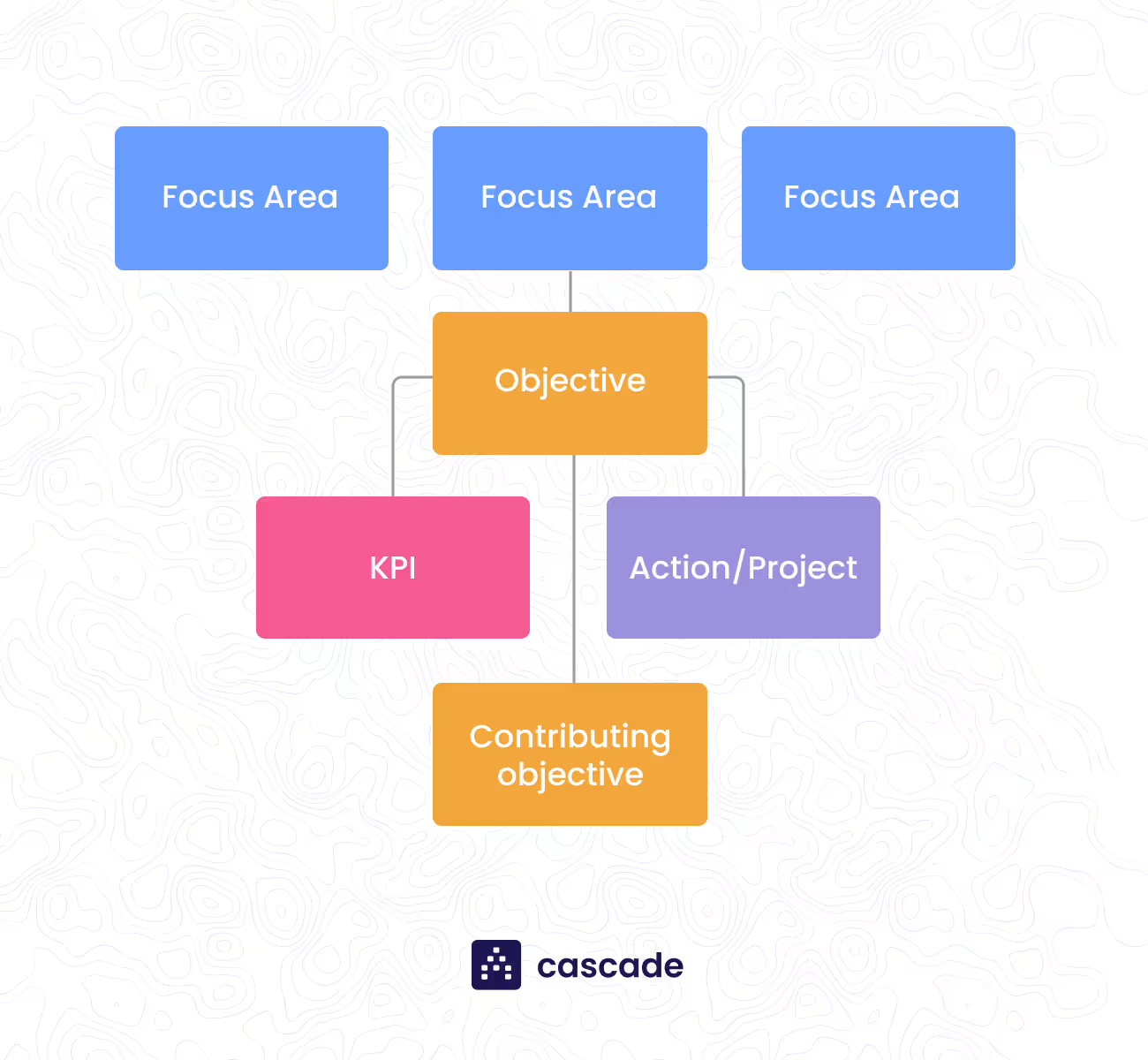
For each contributing objective, you simply repeat the Objective → Action/Project → KPI structure as follows:
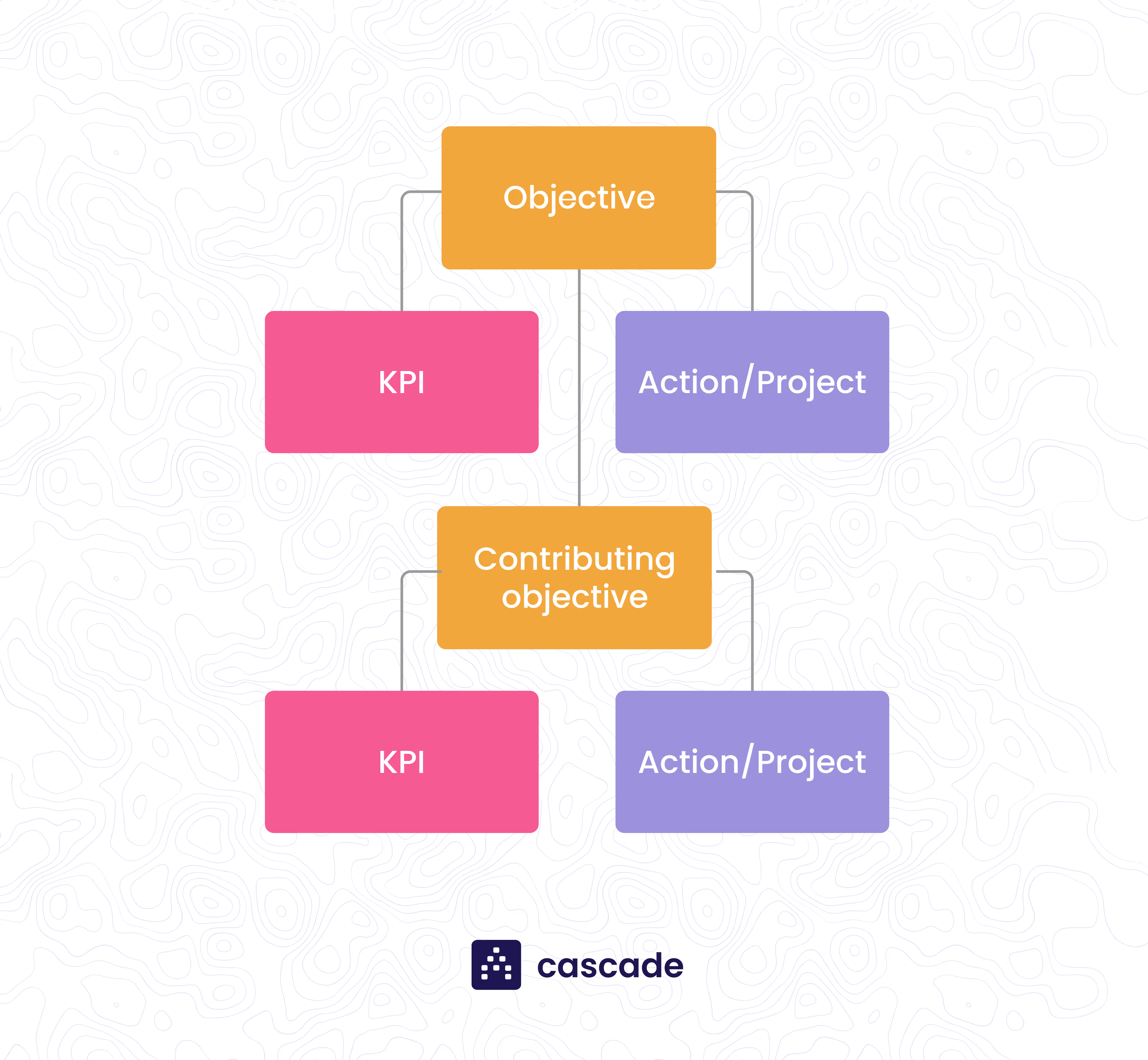
Here's how you can create contributing objectives in Cascade:
Option A: Create contributing objectives within the same plan
This means creating multiple contributing objectives within the same strategic plan that contribute to the main objective.
However, be aware that if you have a lot of layers, your strategic plan can become cluttered, and people might have difficulty understanding how their daily efforts contribute to the strategic plan at the top level.
For example, the people responsible for managing contributing objectives at the bottom of the plan (functional/operational level) will lose visibility on how are their objectives linked to the main focus areas and objectives (at a corporate/business level).
This approach is best suited to smaller organizations that only need to add a few layers of objectives to their plan.
Option B: Create contributing objectives from multiple strategic plans linking to the main objective
This approach creates a network of aligned strategic plans within your organization. Each plan contains a set of focus areas and one single layer of objectives, each with its own set of projects, actions, and KPIs. This concept looks like this:
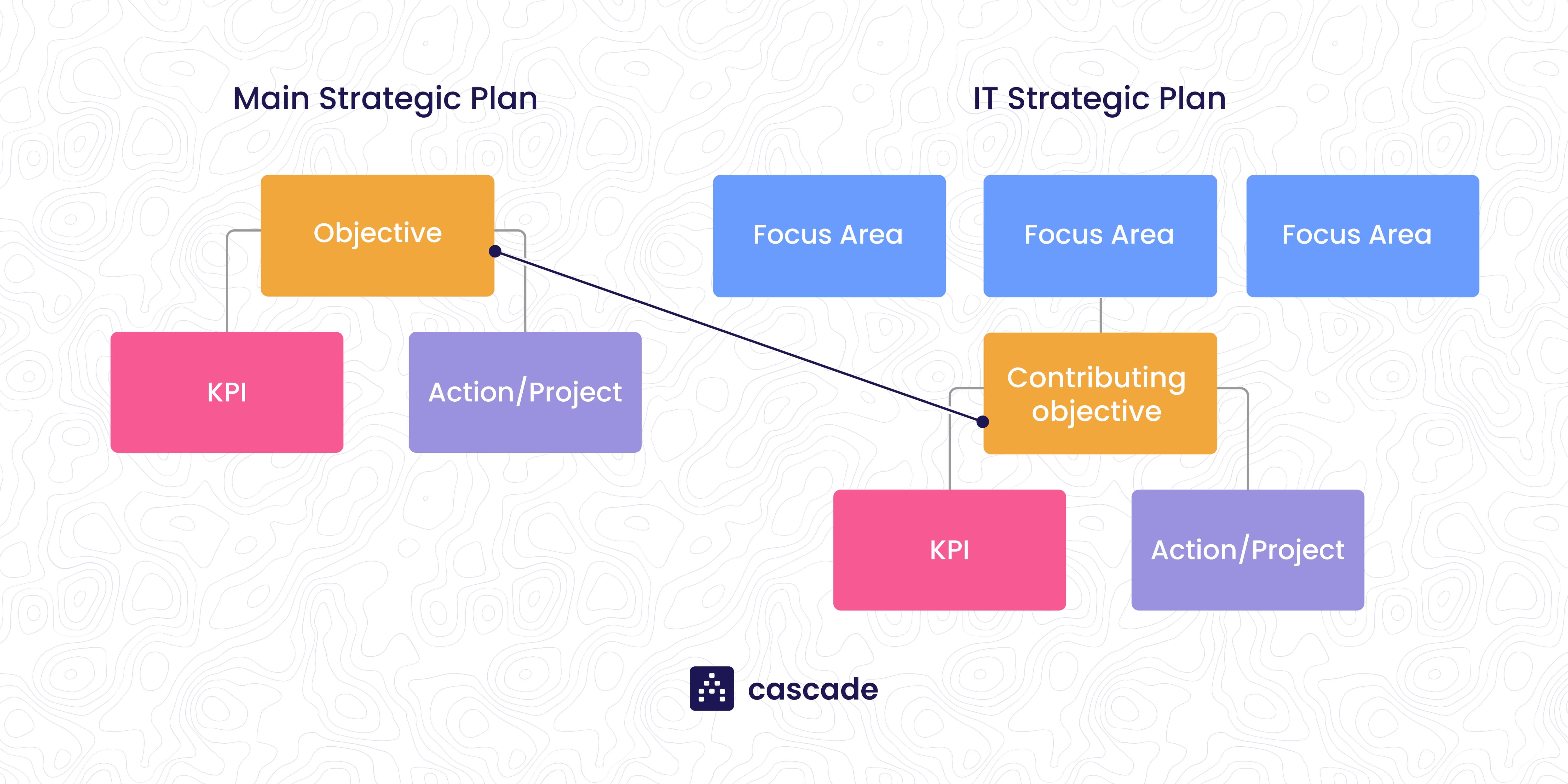
This example illustrates an objective that is a main objective in the IT strategic plan, but also contributes to the main strategic plan's objective.
For example, let's say that your main business objective is to improve customer satisfaction by reducing product delivery time by 25% in the next quarter. This objective requires multiple operational teams within your organization to work together to achieve a shared objective.
Each team will create its own objective in its plan to contribute to the main objective:
- Logistics team: Reduce the shipment preparation time by 30%
- IT team: Implement new technology to reduce manual handling in the warehouse
- Production team: Increase production output by hour for 5%
Here's how this example would look like within the Cascade platform:

Although each contributing objective was originally created in its own plan, you can see how each contributing objective relates to the main strategic objective and its status in real-time.
2. Shared objectives
In Cascade, shared objectives are the same objectives shared across different strategic plans.
For example, you can have an objective that is “Achieve sustainable operations”. This objective can be part of the Corporate Strategy Plan, but also part of the Operations Plan, Supply Chain Plan, Production Plan, etc. In short, this objective becomes a shared objective between multiple teams and strategic plans.
This approach helps you to:
- Cascade your business strategy as deep as you want across a near-infinite number of people while maintaining strategic alignment throughout your organization.
- Create transparency and a much higher level of engagement in the strategy throughout your organization since objective owners are able to identify how their shared efforts contribute to the success of the main business objectives.
The more shared objectives you have across your organization, the more your teams will be aligned with the overarching business strategy. This is what we call "alignment health”.
Here's how you can see the shared objectives in the alignment map and analyze alignment health within Cascade:

You get a snapshot of how your corporate strategic plan is aligned with sub-plans from different business units or departments and the status of shared objectives. This helps you quickly identify misaligned strategic initiatives and act before it's too late. Plus, cross-functional teams have better visibility of how their efforts contribute to shared objectives.
So whether you choose contributing objectives or shared objectives, Cascade has the tools and features to help you achieve organization-wide alignment and boost your bottom line.
Quick Overview Of Key Steps In Writing A Strategic Plan
Here's a quick infographic to help you remember how everything connects and why each element is critical to effective strategic planning:

This simple answer to how to write a strategic plan avoids confusing jargon and has elements that the whole organization can both get behind and understand.
💡Tip: Save this image or bookmark this article for your next strategic planning session.
Create An Execution-Ready Strategic Plan With Cascade 🚀
If you're struggling to write an execution-ready strategic plan, the Cascade Strategy Model is the solution you've been looking for. With its clear, easy-to-understand terminology, and simple linkages between objectives, projects, and KPIs, you can create a plan that's both scalable and flexible.
But why is a flexible and execution-ready strategic plan so important? It's simple: without a clear and actionable plan, you'll never be able to achieve your business objectives. By using the Cascade Strategic Planning Model, you'll be able to create a plan that's both tangible and measurable, with KPIs that help you track progress towards your goals.
However, the real value of the Cascade framework lies in its flexibility. By creating links between main business objectives and your teams' objectives, you can easily scale your plan without losing focus. Plus, the model's structure of linked layers means that you can always adjust your strategy in response to new challenges to easily develop an iterative strategic planning process.
So if you want to achieve results with your strategic plan, start using Cascade today. With its unique combination of flexibility and focus, it's the perfect tool for any organization looking to master strategy execution and succeed in today's fast-paced business world.
Want to see Cascade in action? Get started for free or book a 1:1 demo with Cascade's in-house strategy expert.
This article is part one of our mini-series "How to Create a Strategy". This first article will give you a solid strategy model for your plan and get the strategic thinking going.
Think of it as the foundation for your new strategy. Subsequent parts of the series will show you how to create the content for your strategic plan.
Articles in our "How To Create a Strategy" series
- How To Write A Strategic Plan In 6 Steps + Examples (This article)
- How to Write a Good Vision Statement
- How To Create Company Values
- Creating Strategic Focus Areas
- How To Write Strategic Objectives
- How To Create Effective Projects
- How To Write KPIs
+ Ultimate Guide To Strategic Planning


.avif)

.avif)



.png)
.jpg)
.jpg)



